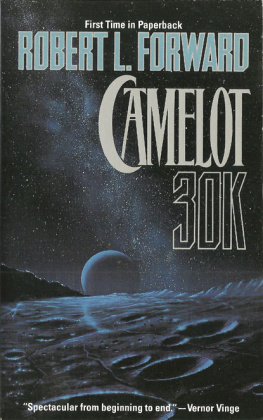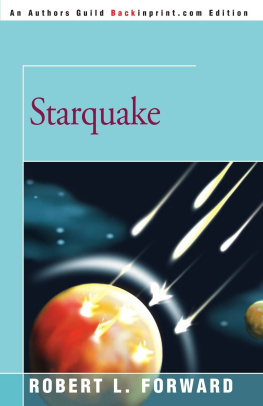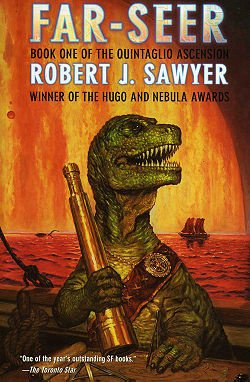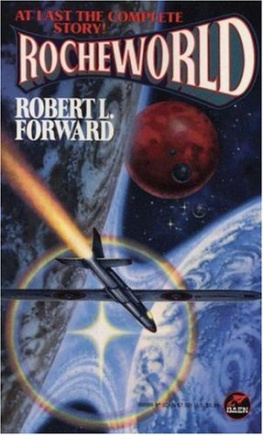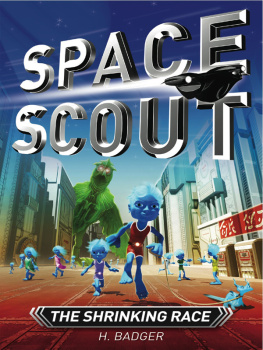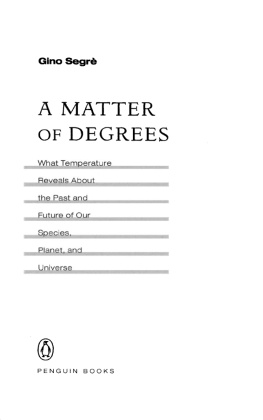Robert L. Forward - Camelot 30K
Here you can read online Robert L. Forward - Camelot 30K full text of the book (entire story) in english for free. Download pdf and epub, get meaning, cover and reviews about this ebook. year: 1996, publisher: Tor Books, genre: Science fiction. Description of the work, (preface) as well as reviews are available. Best literature library LitArk.com created for fans of good reading and offers a wide selection of genres:
Romance novel
Science fiction
Adventure
Detective
Science
History
Home and family
Prose
Art
Politics
Computer
Non-fiction
Religion
Business
Children
Humor
Choose a favorite category and find really read worthwhile books. Enjoy immersion in the world of imagination, feel the emotions of the characters or learn something new for yourself, make an fascinating discovery.
- Book:Camelot 30K
- Author:
- Publisher:Tor Books
- Genre:
- Year:1996
- Rating:5 / 5
- Favourites:Add to favourites
- Your mark:
- 100
- 1
- 2
- 3
- 4
- 5
Camelot 30K: summary, description and annotation
We offer to read an annotation, description, summary or preface (depends on what the author of the book "Camelot 30K" wrote himself). If you haven't found the necessary information about the book — write in the comments, we will try to find it.
Camelot 30K — read online for free the complete book (whole text) full work
Below is the text of the book, divided by pages. System saving the place of the last page read, allows you to conveniently read the book "Camelot 30K" online for free, without having to search again every time where you left off. Put a bookmark, and you can go to the page where you finished reading at any time.
Font size:
Interval:
Bookmark:
(1993)* *
Robert L. Forward
Contents
OUT PAST the planets lie the comets. Some of them are so large that although they are ice-covered on the surface like a comet, they have a rocky core like an asteroid. They can be considered cometoids half comet and half asteroid.
Some think that Pluto is the outermost planet. But Pluto is not a planet. Pluto is a double cometoid consisting of Pluto itself, only two-thirds as big across as the Moon, and Charon, half as large as Pluto. The orbit of Pluto-Charon is highly elliptical and tilted 17 degrees out of the ecliptic plane where all real planets orbit. Pluto's density is only 2.4 times that of ice, indicating a small rocky core with a thick covering of ice, but Charon, with its density of only 1.4, is almost all ice. Certainly these are cometoids , not planets.
The true outer planet of the solar system is Neptune. Its major moon, Triton, is also a cometoid . Triton is made mostly of ice, boasts liquid-nitrogen-driven geysers, and has a tenuous atmosphere. Its average surface temperature is a frigid 38 K, or 38 degrees above absolute zero. Triton's inclined, retrograde orbit indicates that it was originally a giant cometoid that was formed elsewhere. When it wandered too close to Neptune, it collided with one of Neptune's original moons or its upper atmosphere and was captured, the heat generated by its capture evaporating much of its original ice.
It is thought that these giant cometoids originated in the Kuiper Belt, a wide band of icy bodies of varying size postulated to surround the Sun. The Kuiper Belt is thought to merge into the Oort Cloud , a spherical collection of ice-covered bodies loosely bound to the Sun which stretches out to the nearest stars. Before 1992, except for Pluto, which was found only after decades of searching, and the occasional in-falling comet with an apogee calculated to be out in the Kuiper Belt or the Oort Cloud , no object had been observed in those regions.
Then, in 1992, a large ice-covered cometoid was found in the Kuiper Belt. Called 1992 QB1, it had an orbit at 42 AU. This put 1992 QB1 far out past Neptune, whose orbit is at 30 AU. Now that the Kuiper Belt was shown to really exist, the search for its inhabitants intensified. A few years later, shortly before the beginning of the new millennium, the European Infrared Space Observatory was launched. One of its major finds was 1999 ZX. It was the size of Pluto and Triton combined, and orbited at 35 AU. Everyone was amazed that it had been overlooked in previous searches, but when its orbital elements were determined, they understood why. Its position in the sky was near the center of the Milky Way in the constellation Sagittarius, where the background clutter of stars made it difficult to find. Also, 1999 ZX was just approaching its perigee in its highly elliptical orbit and so had been much farther away in previous years. Once the orbit of 1999 ZX was known, its image could be found in retrospective searches of old photographic plates and CCD imager data files, but in each image, bad luck had placed it either near a background star or galaxy, a flaw in the emulsion, or at breaks between CCD pixels.
Fortunately, there had been a breakthrough in high-speed interplanetary transport. It was called the cable catapult. Once a payload had been lifted into Earth orbit using large, slow, and costly chemical rockets, the cable catapult could shoot it out through the solar system at high speed. The catapult consisted of a power supply connected to a long cable that stretched for thousands of kilometers, and a launching motor that rode on the cable. The payload capsule was connected to the launching motor at one end of the cable. The heavy nuclear-thermal-electric power supply then generated a sustained burst of radio frequency energy, which traveled down the conductive cable where it was absorbed by the launching motor. The launching motor then used magnetic coupling to pull on the conducting cable like a monkey climbing a rope, and accelerated toward the power supply and the distant planet. Just before the motor reached the power supply it released the payload capsule, which would travel on to the planet, while the launching motor decelerated to a stop on a short stretch of cable on the other side of the power supply, in a position to accelerate again in order to catch an incoming payload.
The cable catapult was used to launch a flyby robotic probe that passed close to 1999 ZX to take pictures. The scientists and engineers who launched the probe expected the imaging cameras to see an icy surface with many impact craters and perhaps a tenuous atmosphere. They were hoping that they might find something more exciting, like the liquid-nitrogen geysers that had been found on Neptune's cometoid -moon, Triton. When the images came back, however, they contained something that was even more exciting than active geysers ...
There were cities on 1999 ZX!
The cities seemed to be concentrated on relatively flat regions of snow and ice that formed the "plains" between the rocky mountain ranges and a multitude of geyser craters. All the cities had a road network in the form of a spiderweb a spoke-and-ring pattern that radiated outward from a central, circular "park " . At the center of each park was a flat, round "plaza" made of some dark material. The circular cities essentially filled the plains, and were separated from each other by bands of unoccupied ice. What was most amazing about the cities was their small size. An entire city was only a few hundred meters across, and the broadest streets were barely big enough for a human to walk on! The inhabitants must be small indeed.
The finding of cities on 1999 ZX sparked a short resurgence of interest in space exploration. The cable catapult was used to launch a small robotic lander and its massive retrorocket toward the distant cometoid . In 2009, after a long journey through space, the lander settled in the foothills of a mountain chain not too far outside one of the cities. Although the ten-hour round-trip communications time delay made conversation difficult, the scientists on Earth were finally able to establish a dialogue with one of the alien scientists. Her name was Merlene, her people called themselves keracks, and she was the wizard of the city of Camalor, on the planetoid the humans called 1999 ZX and the keracks called Ice.
Although the Earth scientists were overjoyed with the scientific knowledge they were gathering from Merlene, Earth politicians were highly disappointed. The technology of the keracks was far behind that of Earth. There would be no miracles from space to save the human race from its increasingly severe internal problems. Because of the cost of chemical rockets and the protests of environmentalists over the pollution that rockets caused, the rest of the space program was in the process of being contracted. Mars had been abandoned, and the Moon bases were being closed down. Despite this contraction, the scientists and engineers pleaded for a manned mission to 1999 ZX. Finally the politicians relented and gave the technologists their missionbut only if it could be done cheaply. However, propelling a human crew and tons of support equipment over a distance of 35 AU, bringing them to a halt, and landing them on 1999 ZX in less than two decades would require billions of tons of chemical rocket fuel. Even nuclear rockets would require millions of tons of expellant mass. Rockets were too costly.
The space engineers had a simple solution. If rockets were too costlythey wouldn't use them. A second cable catapult was constructed in high Earth orbit. Then the two catapults tossed dummy capsules back and forth at each other over the curved horizon of the Earth that lay between them. With each toss and each catch of a capsule, the catapults reacted by moving slightly farther apart. The catapult in high Earth orbit was pushed off in the direction of Ice; the other was kept tied to Earth by gravity pulling on it one way while the capsule's impulses pushed it the other way. Once the traveling cable catapult had attained cruise velocity, it stopped tossing dummy capsules back to Earth and saved them instead. In 2029, after nearly two decades en route, the traveling catapult approached Ice and shot off the saved capsules to bring itself to a halt
Font size:
Interval:
Bookmark:
Similar books «Camelot 30K»
Look at similar books to Camelot 30K. We have selected literature similar in name and meaning in the hope of providing readers with more options to find new, interesting, not yet read works.
Discussion, reviews of the book Camelot 30K and just readers' own opinions. Leave your comments, write what you think about the work, its meaning or the main characters. Specify what exactly you liked and what you didn't like, and why you think so.

